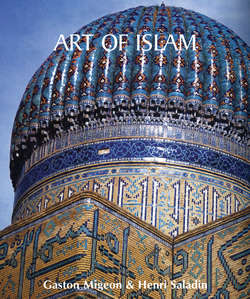Читать книгу Art of Islam - Gaston Migeon - Страница 14
На сайте Литреса книга снята с продажи.
Architecture
B – North Africa and Spain
Palaces
ОглавлениеIn the cities of Kairouan and Córdoba, the magnificence of the sovereigns called for palaces as luxurious as those of Asian caliphs. We know them only from descriptions by Muslim historians. A prominent example is the one that Abd-ar-Rahman had constructed near Córdoba in 926 in honour of his favourite concubine al-Zahra. He called it Madinah al-Zahra (the City of Flowers). This magnificent residence could accommodate the caliph’s court and a guard of 12,000 horsemen. It had a fountain decorated with a golden swan in the caliph’s pavilion. He set up a statue of al-Zahra, his concubine, over the palace’s entrance.
The political change resulting from the battle of Zalaca which brought Spain under the Almoravids – Berbers from the south of Morocco – marked the end of Middle-Eastern supremacy in the area. The policy of the new Berber monarchs involved identifying and propagating small Arab states across the Maghreb that were then considered inoffensive. This change evidently had an impact on the arts, since it was from this period that the Maghrebian style became more defined and distinct from other Muslim styles. Even in independent regions such as Tlemcen, the most beautiful monuments were erected during this period.
A style unique to the Maghreb thus emerged from the independent centres of North Africa. In 1018, the Great Mosque of Algiers had horseshoe-shaped arcades, which were already slightly ogival. With the palace of the grand vizier in Fez in mind, we could compare the modern arch, barely shrunken at the base, with antiquated arches, whose overhang is so distinctive.
